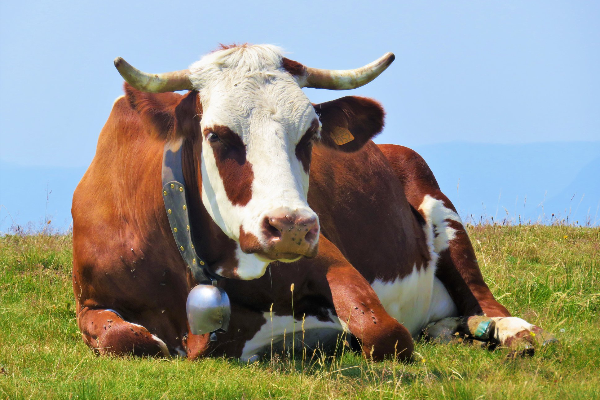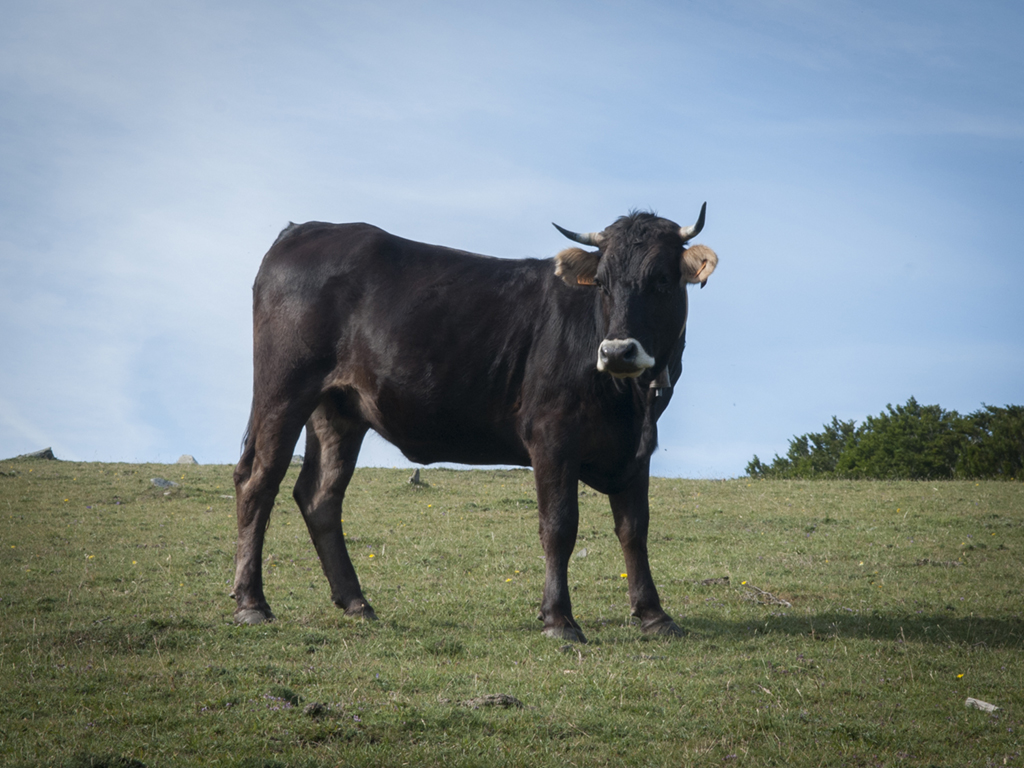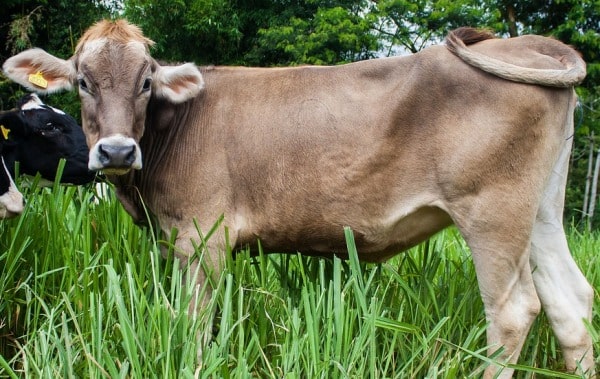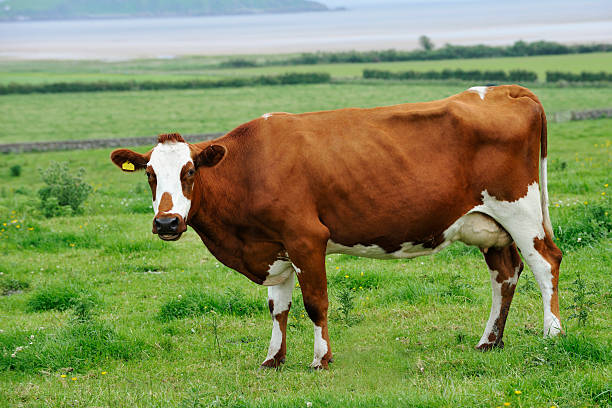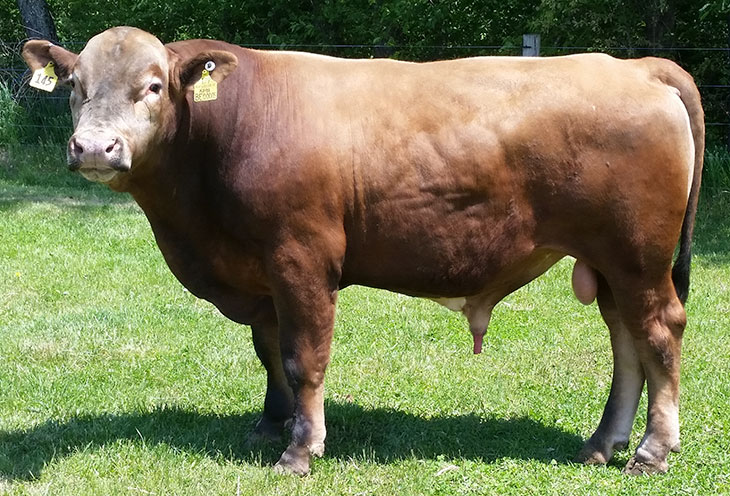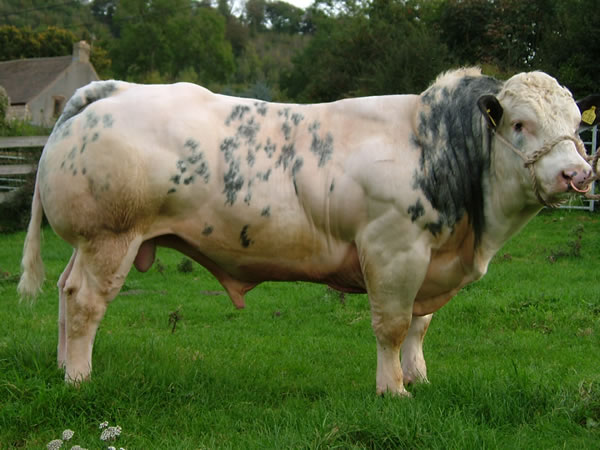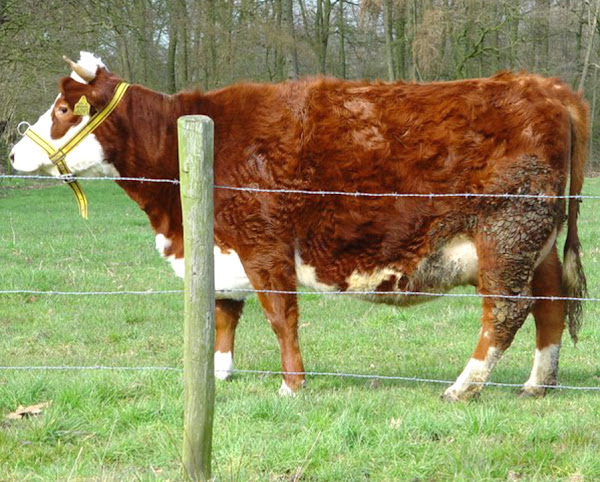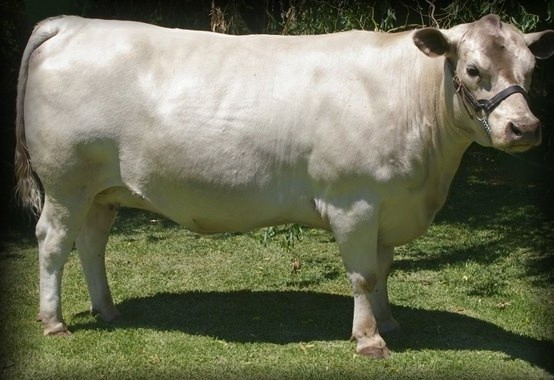Cattle, farm animals that are domesticated and raised for their meat, milk and hides and some others for draft purpose. There are over 1000 breeds of cattle recognized world wide, some of which adapted to the local climate, others which were bred by humans for specialized uses.
Highlights
- History and origin of cattle
- Breeds of cattle
- Fun cattle facts
- Vocabulary terms
- The bottom line
All modern domestic cattle are believed to belong to the species Bos taurus (European breeds such as Shorthorn and Jersey) or Bos indicus (Zebu breeds such as Brahman) or to be crosses of these two (such as Santa Gertrudis). Breeds as they are known today did not always exist, and many are of recent origin. It may be used generally to connote animals that have been selectively bred for a long time so as to possess distinctive identity in color, size, conformation, and function, and these or other distinguishing characteristics are perpetuated in their offspring.
History and origin of cattle
Breeds of Cattle
In no particular order, we’ll be looking at most of the cattle breeds we have;
Aberdeen Angus

The Aberdeen Angus, sometimes simply Angus, is a Scottish breeds of small beef cattle. It derives from cattle native to the counties of Aberdeen, Banff, Kincardine and Angus in north-eastern Scotland. In 2018 the breed accounted for over 17% of the UK beef industry.
The Angus is naturally polled and solid black or red, although the udder may be white. The cattle have been exported to many countries of the world; there are large populations in Australia, Canada, New Zealand, South America and the United States, where it has developed into two separate and distinct breeds, the American Angus and Red Angus. In some countries it has been bred to be taller than the native Scottish stock.
The bulls can weigh about 1000kg and have a height of about 145cm meanwhile cows can weigh up to 650kg, and be 135cm in height.
Abergele
The Abergele cattle are the smallest breed of north Ethiopia. They are reared in the Abergele lowlands and at the southwestern lower slopes of Dogu’a Tembien district. Abergele cattle are part of the Zenga breed group. The Abergele breed is known for its adaptation to the hotter and drier lowlands. It is also very tolerant to diseases and parasites and can cope with feed shortages during long dry periods.
The Abergele cattle generally have red coat colors. Bulls and oxen have thick and short horns and a cervicothoracic hump; cows have medium, thin horns.
Bulls can weigh 234kg with a height of 109cm while cows can weigh 153kg with a height of 97cm.
Abondance
The Abondance is a cross breed of cattle which originated in the high valleys of Haute-Savoie, France. They are a dual purpose breed which are raised for both milk and meat production. Abondance cattle are medium sized animals.
The cows are mainly golden brown in color with white colored underside of the abdomen, head (apart from the eyes) and extremities of their legs. Color of the bulls is different. The bulls are of chestnut red color and a bit of white on the head. Both bulls and cows have horns.
The mature bulls on average weight between 645 and 820 kg. And average live body weight of the mature cows vary from 580 to 680 kg
Afrikaner
The Afrikaner, also known as the Africander, is a breed of taurine-indicine cattle indigenous to South Africa. These typical Bos Indicus animals, the most important of our indigenous breeds, were the first cattle encountered by Jan van Riebeeck shortly after he had arrived at the Cape.
Afrikaners are usually deep red. They have the small cervical-thoracic hump typical of Sanga cattle. The Afrikaner is a well-muscled breed, with long legs and a shallow body. They have long, lateral horns that turn upwards, although these are often polled in commercial operations. Bulls weigh 820–1,090 kg, and cows weigh 450–600 kg. The legs are slightly sickle shaped.
Both bulls and cows have same height of 152cm.
Read also: What is colostrum?
Albera
The Albera cattle are a breed of beef cattle which are raised mainly for meat production. It is an endangered breed of cattle indigenous to the Albera Massif, which divides Catalonia from France and lies partly in the comarca of Alt Empordà in the Catalan province of Girona, and partly in the comarca of Vallespir in the French département of Pyrénées-Orientales. Currently it as endangered breed of small cattle.
They mostly have black colors with bulls weighing about 600kg and cows weighing 580kg.
At the end of 2014 the total population was recorded as 763, of which 618 were female and 145 male.
Alentejana
The Alentejana is a cattle breed from Portugal that was the main breed raised for meat in Southern Portugal historically.
The Alentejana is a medium to large breed and has a golden red color. The horns are large and point forward, with upturned tips. The hind legs are very muscular and strong and the shoulders are long and broad. Their hoofs are well shaped, solid and smooth. They are rustic, energetic and gentle animals.
American Milking Devon
The American Milking Devon is an American breed of dual-purpose cattle, reared both for milk and for beef. It derives from the Devon cattle of the United States, which in turn are derived from the North Devon cattle of south-west England. It was established as a separate breed in 1978 with the formation of the American Milking Devon Cattle Association, after the breeding aims of the Devon were concentrated almost exclusively on beef production.
The American Milking Devon is of medium size: bulls weigh some 500–600 kg (1100–1300 lb), cows about 100 kg (220 lb) less. The coat is a dark, glossy ruby-red. The horns are of medium length, white with black tips. It is physically hardy, with good resistance to harsh weather, and does well on a low-input diet high in forage.
They’re mostly used for draft work, for milk and for beef.
American Brown Swiss
The Brown Swiss or American Brown Swiss is an American breed of dairy cattle. It derives from the traditional triple-purpose Braunvieh (“Swiss Brown”) of the Alpine region of Europe, but has diverged substantially from it. It was selectively bred for dairy qualities only, and its draft and beef capabilities were lost.
The American Brown Swiss is of medium size. The coat is usually a light grayish brown, but varies from almost white to gray or dark brown. There may be some shading in the coat, with the forequarters often darker than the legs and hind parts. The muzzle is black, ringed with creamy white.
Bulls weigh around 900kg and cows weigh around 590-640kg.
American Angus

Australian Friesian Sahiwal
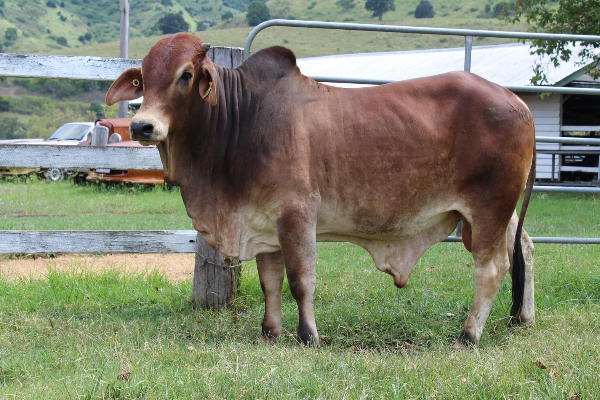
Ayrshire
The Ayrshire breed originated in the County of Ayr in Scotland, prior to 1800 and was regarded as an established breed by 1812. During its development, it was referred to first as the Dunlop, then the Cunningham, and finally, the Ayrshire.
The Ayrshire is a medium-sized breed. The average adult individual “should weigh over 1,200 lb (540 kg) at maturity.” Their milk production can reach 20,000 lb (9,100 kg) or greater per annum.
The cattle are usually red and white in colour, the red varying from very deep to a lighter shade. Calves may be de-horned for ease of handling; if they are not, the horns can grow to 30 cm (12 in) in length. The cattle are typically strong and adaptable to many farming methods, and better suited to extensive management than breeds such as the Friesian.
Bargur Cattle
Bargur cattle is a breed of cattle native to the Bargur forest hills in Anthiyur Taluk of Erode District in Western Tamil Nadu in India. The cattle are usually moderate and compact in build and have brown skin with white patches, though full white and brown complexions are sometimes found. They are known to be very aggressive and of fiery disposition, and hence difficult to train. Accustomed to forest hills of the rugged and inhospitable forests of the Western Ghats, they are best known for their endurance, speed and trotting ability.
Beefalo
Beefalo constitute a hybrid offspring of domestic cattle (Bos taurus), usually a male in managed breeding programs, and the American bison (Bison bison), usually a female in managed breeding programs. The breed was created to combine the characteristics of both animals for beef production.
Beefalo are primarily cattle in genetics and appearance, with the breed association defining a full Beefalo as one with three-eighths (37.5%) bison genetics, while animals with higher percentages of bison genetics are called “bison hybrids”.
A United States Department of Agriculture study found Beefalo meat, like bison meat, to be lower in fat and cholesterol than standard beef cattle.
Belgian blue
The Belgian Blue is a breed of beef cattle from Belgium. It may also be known as the Race de la Moyenne et Haute Belgique, or dikbil (literally “fat buttocks” in Dutch). Alternative names for this breed include Belgian Blue-White; Belgian White and Blue Pied; Belgian White Blue; Blue; and Blue Belgian
The Belgian Blue has a natural mutation in the myostatin gene which codes for the protein, myostatin (“myo” meaning muscle and “statin” meaning stop). Myostatin is a protein that inhibits muscle development. This mutation also interferes with fat deposition, resulting in very lean meat. The truncated myostatin gene is unable to function in its normal capacity, resulting in accelerated lean muscle growth. Muscle growth is due primarily to physiological changes in the animal’s muscle cells (fibres) from hypertrophy to a hyperplasia mode of growth. This particular type of growth is seen early in the fetus of a pregnant dam, which results in a calf that is born with two times the number of muscle fibres at birth than a calf with no myostatin gene mutation.
Bulls weigh around 1200kg while cows weigh about 700kg. the bulls also have a height of about 148cm and cows with a height of 132cm.
Belted Galloway
The Belted Galloway is a traditional Scottish breed of beef cattle. It derives from the Galloway cattle of the Galloway region of south-western Scotland, and was established as a separate breed in 1921. It is adapted to living on the poor upland pastures and windswept moorlands of the region
Galloway cattle are naturally polled (without horns). The most visible characteristics are its long hair coat and the broad white belt that completely encircles its body. Its coarse outer coat helps shed the rain, and its soft undercoat provides insulation and waterproofing, enabling the breed to spend winter outside.
Bulls weigh around 750-1000kg while cows weigh around 450-600kg.
Berrenda Cattle
The Berrenda is a type of cattle from the Spanish region of Andalusia. It is subdivided into two breeds; the Red Berrenda and the Black Berrenda. Both breeds are rustic and very well adapted to the environment.
They’re mostly white with red or brownish patches around they face and small patches on they bodies, with fully red hinds.
Blaarkop
Blaarkop or Groningen is a breed of dairy cattle. Blaarkop is Dutch for blister head. Its main breeding area is in Groningen, Netherlands. The breed has been mentioned as early as the 14th century. From the 19th century, there are also Blaarkoppen in the Utrecht and Leiden regions.
Blaarkop cattle are medium sized animals typically with black color with a white head and belly. Although about 5 percent of the total population are red in color rather than black.
The breed is sturdily built with matching muscles, a horned head and have very strong legs. There are black ring (blister) around their eyes, and the tail has a white tip. Both bulls and cows usually have small horns.
Average body height of the Blaarkop cows vary from 135 to 140 cm, and about 145 to 150 cm for the bulls. The mature bulls on average weight around 800 kg. And average live body weight of the mature cows is around 600 kg.
This cattle breed is raised mainly for milk production.
Brahman
The Brahman is an American breed of zebuine–taurine hybrid beef cattle. It was bred in the United States from 1885 from cattle originating in India, imported at various times from the United Kingdom, from India and from Brazil. These were mainly Gir, Guzerá and Nelore stock, with some Indu-Brasil, Krishna Valley and Ongole. The Brahman has a high tolerance of heat, sunlight and humidity, and good resistance to parasites.
The Brahmans are one of the breeds of cattle that have good tolerance of heat and is widespread in tropical regions. It is resistant to insects thanks to its thick skin. Brahman cattle live longer than many other breeds, often producing calves at ages 15 and older.
the bulls normally have weights ranging from 1600-2200 pounds while cows weigh about 1000-1500pounds. They are mostly used for meat, milk and breeding purposes.
British white
The British White is one of the oldest breeds in Britain with direct links with the ancient indigenous wild white cattle of Great Britain. This breed originated from Whalley Abbey, Lancashire.
The British White has shortish white hair, and has dark points – usually black, but sometimes red. The coloured points include the ears, feet, eyelids, nose and often even teats. It is naturally polled (hornless), medium-sized and compactly built. There may be some coloured spots on the body fur, and the skin beneath the fur is usually coloured (grey or reddish), or pink with coloured spots.
Square meater
The Square Meater is an Australian breed of medium framed, polled cattle which were developed by Rick Pisaturo of Mandalong Park near Sydney, New South Wales in the early 1990s from a base of Murray Grey genetics. Despite their stature they have excellent muscling and perform well in steer and carcass competitions.
Square Meaters are one of the breeds of cattle that are usually silver or grey in colour with dark hooves and a dark skin that reduces the chance of eye cancer and sunburned udders. The breed is noted for its good temperament, early maturity and easy-care attributes, which makes them a popular breed of cattle for smaller farms.
Square Meaters have small frames and short legs, and are naturally polled, but they are not considered to be a miniature breed. Mature bulls weigh between 700 and 800 kg (1,500 and 1,800 lb) and cows range from 400 to 500 kg (900 to 1,100 lb).
Other breeds of cattle include
- Aceh
- Achham
- Adamawa
- Adaptaur
- Afar
- Africangus
- Agerolese
- Alatau
- Albanian
- Albera
- Aleutian Wild
- American White Park
- American
- Amrit Mahal
- Amsterdam Island Cattle
- Anatolian Black
- Angelin
- Ankole-Watusi
- Ankole
- Arado
- Argentine Criollo
- Arouquesa
- Asturian Mountain
- Asturian Valley
- Aubrac
- Aulie-Ata
- Australian Braford
- Australian Brangus
- Australian Lowline
- Australian Milking Zebu
Read also: Difference between alpaca and llama
- Barrosa
- Bazadiase
- Belgian Red
- Beefmaster
- Belmont Red
- Betizu
- Blue Grey
- Boran
- Brangus
- British Friesian
- Brown Caucasian
- Busa Cattle
- Cachena
- Camargue
- Canadian Speckle Park
- Cannadienne
- Canchim
- Carora
- Chianina
- Chillingham Cattle
- Chinese Black Pied
- Danji Cattle
- Danish Jersey
- Danish Red
- Deoni
- Devon
- Dexter Cattle
- Dhanni
- Doayo Cattle
- Drakensberger
- Dølafe
- Droughtmaster
- Dwarf Lulu
- Eastern Finncattle
- Enderby Island Cattle
- English Longhorn
- Estonian Red Cattle
- Evolene Cattle
- Fēng Cattle
- Finnish Ayrshire
- Fjall
- Florida Cracker Cattle
- Fogera
- French Simmental
- Galician Blond
- Galloway Cattle
- Gangatiri
- Gaolao
- Gascon Cattle
- Gelbvieh
- Georgian Mountain Cattle
- German Angus
- German Black Pied
- German Red Pied
- Glamorgan Cattle
- Greek Shorthorn
- Greyman Cattle
- Guernsey Cattle
- Hanwoo
- Hariana Cattle
- Hays Converter
- Heck Cattle
- Hereford
- Herens
- Highland Cattle
- Horro
- Hungarian Grey
- Iberian Cattle
- Icelandic
- Illawarra Cattle
- Indo Brazilian
- Irish Moiled
- Jamaica Hope
- Japanese Brown
- Javari Cattle
- Jersey Cattle
- Jutland Cattle
Read also: Breeds of turkey
- Kangayam
- Kankrej
- Kasaragood Dwarf Cattle
- Kenana Cattle
- Kerry Cattle
- Kostroma Cattle
- Kuri
- Kurgan Cattle
- Latvian Brown
- Lebedyn
- Limia Cattle
- Limousin
- Lincoln Red
- Lithuanian Red
- Lohani Cattle
- Luing
- Madura
- Maine-Anjou
- Malvi
- Marchigiana
- Marinhoa
- Maronesa
- Mewati
- Milking Shorthorn
- Minhota
- Mirandesa
- Mirkadim
- Monchina
- Mongolian
- Muturu
- Murboden
- Murray Grey
- Nagori
- N’Dama
- Negra Andaluza
- Nelore
- Nguni
- Nimari
- Normande
- Northern Finncattle
- Norwegian Red
- Ongole
- Original Simmental
- Pajuna
- Palmera
- Pasiega
- Pembroke
- Philippine Native
- Pie Rouge des Plaines
- Pineywoods
- Pinzgauer
- Pireniaca
- Podolica
- Polish Red
- Polled Hereford
- Polled Shorthorn
- Ponwar
- Preta
- Punganur
- Pulikulam
- Pustertaler Sprinzen
- Qinchaum
- Queensland Miniature Boran
- Ramo Grande
- Randall
- Raramuri Criollo
- Rathi
- Raya
- Red Angus
- Red Brangus
- Red Bororo
- Red Fulani
- Red Chittagong
- Red Gorbatov
- Red Holstein
- Red Kandhari
- Red Poll
- Red Sindhi
- Riggit Galloway
- Ringamala
- Romagnola
- Romosinuano
- Russian Black Pied
- Sahiwal
- Sibi Bhagnari
- Salers
- Sanga
- Santa Gertrudis
- Santa Cruz
- Sayaguesa
- Selembu
- Senepol
- Shetland
- Shorthorn
- Simmental
- Siri
- South Devon
- Spanish Fighting Bull
- Speckle Park
- Stabilizer
- Sussex
- Swedish Friesian
- Swedish Polled
- Sokoto Gudali
- Swedish Red Pied
- Swedish Red Polled
- Swedish Red&White
- Tarentaise
- Tasmanian Grey
- Telemark
- Texas Longhorn
- Texon
- Thai Black
- Thai Fighting Bull
- Thai Friesian
- Thai Milking Zebu
- Tharparker
- Tswana
- Tudanca
- Tuli
- Turkish Grey Steppe
- Tyrol Grey
Read also: Daily routine of a farmer
- Umblachery
- Ukranian Grey
- Vaynol
- Vechur
- Volinian Beef
- Vestland Fjord
- Vestland Red Polled
- Vianesa
- Väneko
- Valdostana Castana
- Valdostana Pezzata Nera
- Valdostana Pezzata Rossa
- Vorderwald
- Wagyu
- Waguli
- Wangus
- Welsh Black
- Western Finncattle
- White Fulani
- White Lamphun
- White Park
- Whitebred Shorthorn
- Xingjiang Brown
- Yakutian
- Yanbian
- Yanhuang
- Yurino
- Zubron
- Zebu
Fun cattle facts
-
- Cattles are ruminant animals, so they have four stomachs (rumen, recticulum, omasum and abomasum)
- Cattles can see almost 360 degrees. As a result of this near-panoramic view, they can watch for predators from all angles. However, they don’t see well straight in front of them and they will typically turn their head to look at you.
- Cattles have an acute sense of smell and can detect odors up to six miles away.
- Cattles have no upper front teeth. Therefore, when they’re eating food, they press their sharp bottom teeth against the top hard palate of their mouth to cut blades of grass.
- A cattle will chew for up to eight hours a day, and can move their jaws about 40,000 times a day.
- Cattles spend about 10 hours a day lying down, and they will stand up and lay down about fourteen times a day. Cows can sleep while they’re standing.
- The first cow arrived in the U.S. in 1611 in Jamestown.
- Cattles can see color. They can even see red. When you see a Matador waving a red flag at a bull (a male cattle), the bull charges because of the flag’s movement.
- The average body temperature of a cow is 102 degrees Fahrenheit.
- Cattles regurgitate, they bring food out of they stomach and chew properly. All ruminant animals do this.
Read also: Breeds of pigs
Vocabulary terms
Cattle: generic, plural term for all cows, bulls, calves, heifers and steers
Herd: group of cattle
Cow: female that has had at least one calf
Bull: mature male used for breeding
Calf: male or female less than 1 year old
Heifer: female that has never had a calf
Steer: young male that has been neutered
Dam: The mother of a calf.
Dehorn: The removal of the horns of horned cattle.
Polled: Naturally hornless cattle.
Read also: List of farm animals with fun facts
The bottom line | breeds of cattle
We have almost all breeds of cattle above, all characteristics and photos will be updated from time to time. Black Angus is the most common breed of beef cattle with more than 330,000 animals registered.
Chianinas are the largest breeds of cattle in the world. It originated in Tuscany, Italy, and it can reach a height of 2m and a weight of more than 1,700 kg.
Vechur cow, an indigenous cattle variety of Kerala, a rare breed of Bos indicus, is the smallest cattle breed in the world. With an average length of 124 cm (about 4 feet and 1 inch) and height of 87 cm (about 2 feet and 10 inches), it is the smallest cattle breed in the world.
Holstein breeds of cattle has the highest milk production of all dairy breeds. The Holstein is the dominant dairy breed in the U.S. • The average Holstein cow produces around • 23,000 pounds of milk, or 2,674 gallons, of milk each lactation.
Angus is the most popular breed of beef cattle. Their meat quality is excellent and they provide 50 percent of their weight in the meat.
Please share

